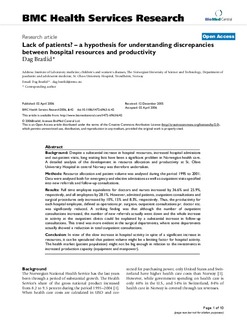Lack of patients? a hypothesis for understanding discrepancies between hospital resources and productivity
Journal article, Peer reviewed
Permanent lenke
http://hdl.handle.net/11250/300627Utgivelsesdato
2006Metadata
Vis full innførselSamlinger
Sammendrag
Background: Despite a substantial increase in hospital resources, increased hospital admissions
and out-patient visits, long waiting lists have been a significant problem in Norwegian health care.
A detailed analysis of the development in resource allocation and productivity at St. Olavs
University Hospital in central Norway was therefore undertaken.
Methods: Resource allocation and patient volume was analysed during the period 1995 to 2001.
Data were analysed both for emergency and elective admissions as well as outpatient visits specified
into new referrals and follow-up consultations.
Results: Full time employee equivalents for doctors and nurses increased by 36.6% and 25.9%,
respectively, and all employees by 28.1%. However, admitted patients, outpatient consultations and
surgical procedures only increased by 10%, 15% and 8.3%, respectively. Thus, the productivity for
each hospital employee, defined as operations pr. surgeon, outpatient consultations pr. doctor etc.
was significantly reduced. A striking finding was that although the number of outpatient
consultations increased, the number of new referrals actually went down and the whole increase
in activity at the outpatient clinics could be explained by a substantial increase in follow-up
consultations. This trend was more evident in the surgical departments, where some departments
actually showed a reduction in total outpatient consultations.
Conclusion: In view of the slow increase in hospital activity in spite of a significant increase in
resources, it can be speculated that patient volume might be a limiting factor for hospital activity.
The health market (patient population) might not be big enough in relation to the investments in
increased production capacity (equipment and manpower).
